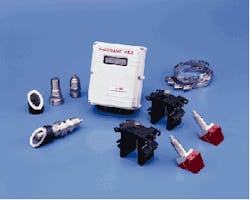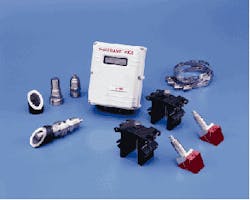Flowmeter Meets Need for Low Cost, Ease of Installation
Flow measurement is required for many municipal applications such as collection, treatment, and distribution of potable water; wastewater influent and effluent; and sanitary and storm water collection. In some of these situations, flowmeters are used for monitoring; in others, they may be employed for process control. Either way, the municipal market needs flowmeters that are simple to install and set up.
Panametrics' new AquaTrans AT868 Ultrasonic Liquid Flow Transmitter is specifically engineered to meet these needs. The AT868 combines a state-of-the-art, low-cost flow transmitter with Panametrics' ultrasonic flowmeter technology for water and wastewater applications.
The flowmeter is microprocessor-based and has software specifically designed for simple setup. The NEMA 4X, low-profile transmitter can be positioned in an accessible location close to the measurement point by mounting it either on a wall or a two-inch pipe stand. The two-line, 16-character, LED backlit, LCD display shows up to four flow parameters in sequence. An RS232 port permits a digital link that allows configuration of the meter using a PC and the included Instrument Data Manager interface software. The flowmeter has one 4-20 mA analog output and one frequency/pulse rate/totalizer output.
The transit-time flow measurement technique uses a pair of transducers, each of which sends and receives coded ultrasonic signals through the fluid stream. It takes less time for the downstream transducer to receive the signal from the upstream transducer than it does for the upstream transducer to receive the signal from the downstream transducer. The difference between these transit times is proportional to the velocity of the flowing liquid. This technique is also applicable to bidirectional flow, and it works both in clean water and in wastewater with up to 15 percent entrained solids.
The AT868 uses digital signal processing to measure the difference in transit times. The flowmeter then applies cross-correlation algorithms to the transit-time measurements and preprogrammed pipe setup data to calculate the volumetric flow. Either clamp-on or wetted transducers can be used. Both types of installations are obstructionless and will not cause a pressure drop. Transducers are connected to the AT868 electronics by means of coaxial cables.
Wetted transducers are generally employed in new facilities since they can easily be included in the initial construction. They are also typically used in environments with inconvenient access, such as tunnels and underground vaults. Wetted installations use a nozzle welded into the process pipe at a prescribed angle. The inclusion of a Pan-Adapta plug, a special adapter that allows removal of the transducer without interrupting the process or emptying the pipe, is highly recommended.
Clamp-on transducers offer maximum convenience and flexibility. They are attached to the outside of the pipe with simple mounting blocks and stainless steel straps. Installation can take as little as half an hour to complete and verify. There is no need to shut down the process, no cutting or tapping of the pipe is required, and there are no wetted parts in contact with the process fluids.

